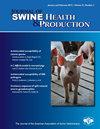最小化育婴场后备猪的策略
IF 0.7
4区 农林科学
Q3 Agricultural and Biological Sciences
引用次数: 0
摘要
断奶前策略,以尽量减少后备猪在托儿所,包括交叉培育,爬行喂养和断奶的老猪。断奶后尽量减少保育室后备猪的策略包括最佳谷仓温度和通风设置点、方便获得饲料和水以及积极的安置策略。与断奶猪的营养需求和消化能力相匹配的分阶段喂养计划也至关重要。管理后备清管器可以通过最大限度地减少移除围栏中的气流、提供补充热源、通过提供稀粥和垫料提供多个饲料接入点以及确保对移除围栏中清管器进行更深入的观察来实现。本文章由计算机程序翻译,如有差异,请以英文原文为准。
Strategies to minimize fallback pigs in the nursery
Preweaning strategies to minimize fallback pigs in the nursery include cross fostering, creep feeding, and weaning an older pig. Postweaning strategies to minimize fallback pigs in the nursery include optimum barn temperature and ventilation set points, easy access to feed and water, and proactive placement strategies. Phase-feeding programs to match the nutrient requirements and digestive abilities of weaned pigs are also crucial. Managing fallback pigs can be accomplished by minimizing drafts in removal pens, providing supplemental heat sources, having multiple feed access points by providing gruel and mat feed, and ensuring more intensive observations of pigs in removal pens.
求助全文
通过发布文献求助,成功后即可免费获取论文全文。
去求助
来源期刊
CiteScore
1.80
自引率
0.00%
发文量
29
审稿时长
>36 weeks
期刊介绍:
The Journal of Swine Health & Production (JSHAP) is an open-access and peer-reviewed journal published by the American Association of Swine Veterinarians (AASV) since 1993. The aim of the journal is the timely publication of peer-reviewed papers with a scope that encompasses the many domains of applied swine health and production, including the diagnosis, treatment, management, prevention and eradication of swine diseases, welfare & behavior, nutrition, public health, epidemiology, food safety, biosecurity, pharmaceuticals, antimicrobial use and resistance, reproduction, growth, systems flow, economics, and facility design. The journal provides a platform for researchers, veterinary practitioners, academics, and students to share their work with an international audience. The journal publishes information that contains an applied and practical focus and presents scientific information that is accessible to the busy veterinary practitioner as well as to the research and academic community. Hence, manuscripts with an applied focus are considered for publication, and the journal publishes original research, brief communications, case reports/series, literature reviews, commentaries, diagnostic notes, production tools, and practice tips. All manuscripts submitted to the Journal of Swine Health & Production are peer-reviewed.

 求助内容:
求助内容: 应助结果提醒方式:
应助结果提醒方式:


